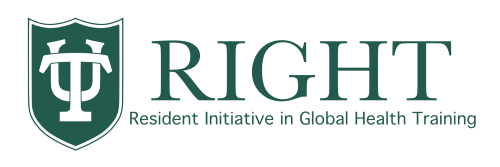
The Resident Initiative in Global Health Training (RIGHT) program will provide skills and training to residents interested in a career path in global health. By offering opportunities for residents to expand their medical knowledge and experience internationally, the program aims to add to the community of ethically guided advocates for evidence-based holistic approaches to equitable care, locally and abroad.
This program is in addition to your current residency. You must be in good standing during your residency program to participate in the RIGHT Program.
Our Mission
We in the RIGHT program believe in health as a human right in an age of growing healthcare disparities. The RIGHT program advocates for ethically-guided, evidence-based, and holistic approaches to care both locally and abroad. Global health equity is at the core of what we do. Our program is a 3-year training for Tulane residents interested in a global health career.
Eligibility and Selection
Residents of all specialties are welcome to join the RIGHT program and participate in our curriculum. However, we have limited funding to provide financial support for international rotations. Therefore, the RIGHT scholarship (and only the scholarship) is based on application and interview. All other resources are available to those who demonstrate interest.
Program Requirements
The RIGHT program is incorporated into your current residency program. Once accepted to the program, you will be required to attend a majority of the seminars, participate in the online curriculum, complete a scholarly project, and meet regularly with your mentor. Additionally, RIGHT scholars will be encouraged to work with underserved populations locally.
Program Benefits
As a RIGHT resident, you will have access to mentorship and educational resources through Tulane University. Further, all residents who complete the five core components are eligible for the global health certification with diplomas given at graduation.
Resident Scholarly Projects and Publications:
- Aoun, E., Colon-Rivera, H., Malone, P., Teverbaugh, L. (2017, May). “The Use of Medication-Assisted Treatment and Behavioral Strategies to Treat Adolescents with SUDs”. Workshop presentation at American Psychiatric Association Annual Meeting. San Diego, CA.
- Gordon K., Teverbaugh L.A. "Human Trafficking." (2016, November) Presentation at Black Psychiatrists of America Annual Transcultural Conference.
- Nassau, Bahamas. Gleason, M.M. & Teverbaugh, L.A. (2016). Updates in pediatric preschool psychopharmacologic treatment. in J. Luby (Ed.), Handbook of Preschool Mental Health: Development, Disorders, and Treatment. Guilford Press.
- Gillette MA, A Long Argument With the Specter of Death: A Physician's Review of “Mortality". J Miss State Med Assoc, 2014: 55 (2), 45.
- Boehme AK, Gillette MA, Kumar AD, Siegler JE, Albright KC, Martin-Schild S. Persistent Leukocytosis- Is this a Persistent Problem. J Stroke Cerebrovasc Dis. 2014: 23 (7) 1939-1943.
- Siegler JE, Kumar AD, Gillette MA, Albright KC, Boehme AK, Martin-Schild S. What Change in the National Institutes of Health Stroke Scale Should Define Neurologic…
- Assessing Engagement of Adolescents and Young Adults (AYA) in HIV Research: A Multi-method Analysis of a Crowdsourcing Open Call and Typology of AYA Engagement in Sub-Saharan Africa Kadija M Tahlil # 1, Laura Rachal # 2, Titi Gbajabiamila # 3, Ucheoma Nwaozuru 4, Chisom Obiezu-Umeh 4, Takhona Hlatshwako 5, Mandikudza Tembo 6, Nicola Willis 7, Carine Oum Nyagog 8, Susan Vorkoper 9, Rachel Sturke 9, Nora E Rosenberg 10, Victor Ojo 3, Isaac Moses 3, Nadia Ahmed 11, Kristin Beima-Sofie 12, Sarah T Roberts 13, Brenda Kateera 14, Eleanor Namisoke-Magongo 15, Michael T Mbizvo 16, Juliet Iwelunmor 4, Oliver Ezechi 3, Joseph D Tucker 17 18 19
- Xpert Ultra versus Xpert MTB/RIF for pulmonary tuberculosis and rifampicin resistance in adults with presumptive pulmonary tuberculosis. The Cochrane database of systematic reviews. 2021 Review
- BMI is Associated with Coronavirus Disease 2019 Intensive Care Unit Admission in African Americans. Obesity (Silver Spring, Md.). 2020 Academic Article
- Collaborate to cure: a student perspective on global health. Lancet (London, England). 2015 Letter
- Teaching corner: an undergraduate medical education program comprehensively integrating global health and global health ethics as core curricula : student experiences of the medical school for international health in Israel. Journal of bioethical inquiry. 2015 Academic Article
